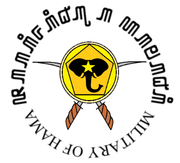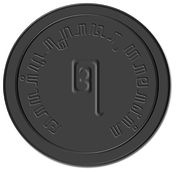Difference between revisions of "Hamanian Empire"
(→War for Southern Itur) |
|||
| Line 6: | Line 6: | ||
|national_motto = Unity is strength (Hamanese: ''Mudu sa madu'') | |national_motto = Unity is strength (Hamanese: ''Mudu sa madu'') | ||
|national_anthem = ''God save the King'' (Hamanese: ''Allahu siza Maliku'') | |national_anthem = ''God save the King'' (Hamanese: ''Allahu siza Maliku'') | ||
| − | |image_flag = | + | |image_flag = Gold Star Flag.png |
| − | |image_coat = | + | |image_coat = Emblem of Hama.png |
| − | |flag_caption = | + | |flag_caption = Gold Star Flag |
|image_map = Imperial Map.png | |image_map = Imperial Map.png | ||
|loctext = | |loctext = | ||
Revision as of 03:01, 21 April 2018
| This page is a work in progress by its author(s) and should not be considered final. |
| Hamanian Empire | |||||
|---|---|---|---|---|---|
|
|||||
| Motto: Unity is strength (Hamanese: Mudu sa madu) | |||||
| Anthem: God save the King (Hamanese: Allahu siza Maliku) | |||||
| Capital and largest city | Komodu | ||||
| Official languages | Hamanese language, Borean and Avanian | ||||
| Ethnic groups (2016) | Humans, giants and wolves | ||||
| Demonym | Hamanian | ||||
| Government | Empire | ||||
| - | King | Maduallahu | |||
| Legislature | Parliament | ||||
| - | Upper house | Council of Chiefs | |||
| - | Lower house | House of the People | |||
| Establishment | |||||
| - | Invasion of Borea | ||||
| - | Invasion of Itur | ||||
| - | Invasion of the Azurian Islands | ||||
| - | Independence of the Azurian Islands | ||||
| Area | |||||
| - | Total | unknown km2 unknown sq mi |
|||
| Population | |||||
| - | estimate | unknown | |||
| - | Density | unknown/km2 Expression error: Unrecognized word "unknown"./sq mi |
|||
| GDP (nominal) | estimate | ||||
| - | Total | unknown | |||
| - | Per capita | unknown | |||
| HDI | unknown Error: Invalid HDI value |
||||
| Currency | dahab | ||||
| Date format | varies | ||||
| Drives on the | varies | ||||
| ISO 3166 code | VARIES | ||||
| Internet TLD | varies | ||||
The Hamanian Empire is made up of all the territories ruled by the Kingdom of Hama. It originated with the invasion, occupation, and annexation of eastern Borea in the late 17th and early 18th centuries. It is primarily made up of territory in the Yasteria supercontinent/geographic region of Urth.
Contents
History
Founding
The Kingdom of Hama was founded in the 14th century. King Hama united the tribes of mainland Hama. They signed a treaty in which the chiefs of the tribes pledged allegiance to the King and agreed to amalgamate their tribal lands into one nation-state.
Colonisation of Borea
In 1590, Ali Matu asked King Ahamadu for funding to explore Borea. The King agreed and Matu arrived in Borea. He had a clandestine mission to prospect for gold. The King had been aware of this, but he needed Ali to collect information that would aid in the colonization of Borea. The King used this information to send General Yeshu Abadulahu to invade and colonize Borea. He built the city of Ahamadu and a castle inland. The native population was displaced and enslaved over the next 60 years. The eastern portion of Borea was taken over by Hama and the boundaries of its colony were fixed as the colonization process stabilized.
Kalatian-Hamanian War
The Kalatian-Hamanian War was a protracted armed conflict that took place in Borea primarily between Kalatianburg and Hama.
War for Southern Itur
In the 1700, Shafiru Mahadu built a small city on Isa Island, south of Itur. He traded with the native lupine population. Bakiru Lahidu triggered a war with the Warren people of Warreland when he captured their princess and paraded her as a circus attraction in 1729. The Warren people attacked Port Isa in 1730. They defeated their defenses. The Hamanians retreated to the massive Fort Isa. King Musa of Hama sent reinforcements who defeated the wolves in the Battle of Port Isa and reclaimed the city.
Members
Hama (the Kingdom of Hama) Hamanian Borea
Former members
Mocambyk
Politics
The politics of the Hamanian Empire take place in the framework of a monarchy. The King is elected by the Council of Chiefs for life. This is currently Maduallahu. He is the head of the empire and of the military. He appoints the cabinet of Hama, viceroys, generals, senior civil servants and ambassadors. The Parliament forms the highest law making branch. The Council of Chiefs is comprised of the tribal rulers of Hama, and possess the power to pass laws. The House of the People is elected but serves as a rubber stamp body on the government's authority.
Territories have varying levels of autonomy. The Realm of Avania is located in northeast Borea. It is largely autonomous except in matters of foreign, monetary and defence policy. The Cities of Abadulahu and Ahamadu are directly administered by the crown. The Realm of Borea has the power to legislate on issues devolved to it by the Parliament. Each territory has a Viceroy who represents the King. Through the secret services, the military, economic dominance and legal instruments, the central government retains a vast amount of influence over the affairs of its colonies.
Military
The armed forces of Hama compromise military of the Hamanian Empire. They are made up of three branches. The King has the sole power to declare war and make peace. He has supreme direction of the armed forces. He is advised by his Cabinet on matters of defence policy. The Minister of Defence handles the daily administration. The Chief of Staff is the highest professional officer and oversees the daily operations of the armed forces. Paramilitary forces exist that are administered by the territorial government to supplement the military and law enforcement.
Foreign relations
The foreign policy of the Hamanian Empire is shaped by the central government in Hama. The Parliament has the sole power to ratify treaties. The King has the sole power to appoint and dismiss diplomats and to receive foreign emissaries and recognise governments. Some colonies pursue international cooperation under the framework of the central government.
Legal system
The legal system that is applied in each part of the empire varies, according to the needs of that society. In the Realm of Avania, some civil disputes are resolved by traditional leaders such as elders and chiefs. In the Kingdom of Hama and the Realm of Borea, there is a centralised judiciary that is divided into appellate and trial courts, administers justice. Indigenous traditions serve as law in some jurisdictions and in some cases. Some legal principles arise from the central authorities in Hama, while some arise from the territorial government.
Economy
The economy of the Hamanian Empire generally takes place in the framework of a mixed economy. Avania has a relatively traditional economy. Borea and Hama have a mix of state and private sector. The cities of Ahamadu and Abadulahu have a strong private sector.
The Hama is generally classified as an upper-income country. It has a large economic output. It has a large services sector and strong manufacturing sector. Its largest sectors are financial services, shipping, and tourism. The largest manufacturing sectors are diamond cutting and polishing, arms and electronics. Due to the aridity and heat of the south, agriculture is limited to the north. Fruits and vegetables are the primary products. It is a major producer of animal products such as ivory, scales, pelts, and horns. Hama has well-developed water, energy, transport and communications infrastructure.
Avania is a largely low-income region. It has a large agriculture industry. It produces fruits, vegetables, wheat, rice, and maize. It has a large meat and dairy product sector. It is the largest producer of wines in the empire. It also produces a large amount of timber. Borea is a middle-income region. It has a large mining sector. It is a major source of precious metals such as silver and gold, and metals such as nickel, copper, and iron. It has a large fishing sector. It is a major supplier of freshwater salmon and caviar, and of saltwater fish such as hake and mackerel. It has a large metallurgical sector. Abadulahu is a major fishing and logistics. Ahamadu is the biggest port in Hamanian Borea and is a major logistical and administrative center. Generally Ahamadu and Abadulahu have well-developed infrastructure.
The empire has strong gold reserves of a couple hundred billion dollars. It has an advanced banking sector. Ahamadu has been accused of acting as a tax haven. Although the rest of Hama and its territories have adopted policies to increase transparency and tackle tax evasion and money laundering, Ahamadu has low taxes and secretive banking laws. The government has repeatedly ignored calls to tighten that sector. In general, the economy is diverse, with small and medium-sized businesses playing a strong role. In the colonies, energy, transport infrastructure, water, health, and energy are monopolized in state hands. There is an above average level of inequality in Hama, low level of inequality in Avania and a very high level of inequality of Borea, Ahamadu, and Abadulahu. The currency of the entire empire is the dabab.



